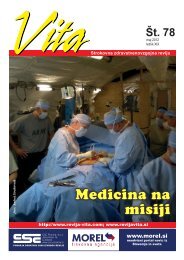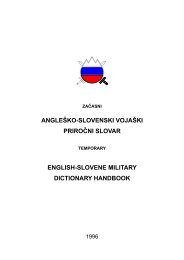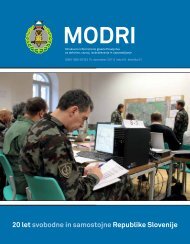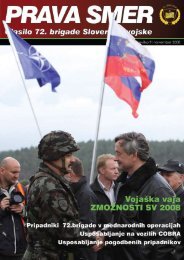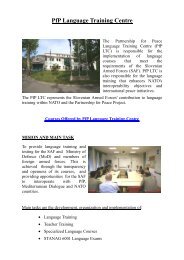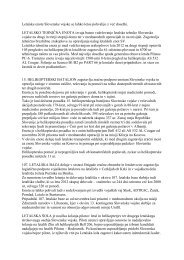Letnik 9/2, september 2007 - Slovenska vojska
Letnik 9/2, september 2007 - Slovenska vojska
Letnik 9/2, september 2007 - Slovenska vojska
Create successful ePaper yourself
Turn your PDF publications into a flip-book with our unique Google optimized e-Paper software.
NESLIŠNO OROŽJE: RAZVIJANJE OBVEŠČEVALNEGA SODELOVANJA V ...<br />
targeted killing) is not likely to diminish in the near term. Indeed, to the extent that<br />
the quasi or fully autonomous nature of terrorist cells increase (as would appear<br />
to be the case with the Madrid, London and perhaps Mumbai train bombings),<br />
even more of a premium will be placed on the rapid acquisition and transmission<br />
of actionable intelligence to the appropriate parties. In short, the intelligence<br />
weapon has demonstrated its clear utility in combating Jihadist terrorism and has<br />
indisputably saved lives, quite possibly many lives, through the apprehension<br />
and elimination of a number of prominent terrorist personalities. Absent effective<br />
intelligence, the successful application of military force against a terrorist target is<br />
likely to be severely limited.<br />
Despite its successful record as a counterterrorism tool to date, there are sufficient<br />
challenges and potential problems to ensure that wielding the intelligence weapon<br />
against terrorists will remain a complex task. It is notable in this sense that most<br />
of the public controversies surrounding methods the U.S. is employing to combat<br />
terrorism have involved intelligence operations. These range from the legality<br />
of CIA targeted killings (resulting in the death of a U.S. citizen in at least one<br />
instance) to issues surrounding NSA telephone intercepts and data mining to the<br />
existence of secret prisons and the associated issue of permissible interrogation<br />
methods 3 (Eichensehr, 2003). For professional intelligence officers, military and<br />
civilian, these areas represent an operational Terra Incognita. An appropriation of<br />
Lincoln’s phrase, made in an entirely different context, is arguably apt: “Just as our<br />
case is new, so must we think anew and act anew.” (Lincoln, 1862) Over time, it<br />
can be expected that intelligence agencies will critically assess and, where needed,<br />
refine the methods they are employing against the terrorist target, based on results<br />
and consonant with the constraints imposed by a democracy operating under rule<br />
of law. Course-adjustment and judgment as to which methods are fundamentally<br />
sound and which are not, cannot, of course, be expected to take place overnight.<br />
Nonetheless, many intelligence officials agree that the face of intelligence-driven<br />
counterterrorist activities to be encountered five years from now will likely have<br />
a significantly different appearance from the circumstances encountered today.<br />
The issue of interrogation techniques permitted for the CIA to employ against<br />
terrorist detainees is illustrative of this point. It now appears that, in the months and<br />
years following 9/11, these interrogation practices lacked a sufficient, or at least<br />
sufficiently clear, legal framework. The issue was only resolved (at least to some<br />
extent) with authority in late 2006, following robust political debate. It is likely<br />
3<br />
The intelligence methods employed in combating terrorist targets have been the subject of robust public debate.<br />
90



